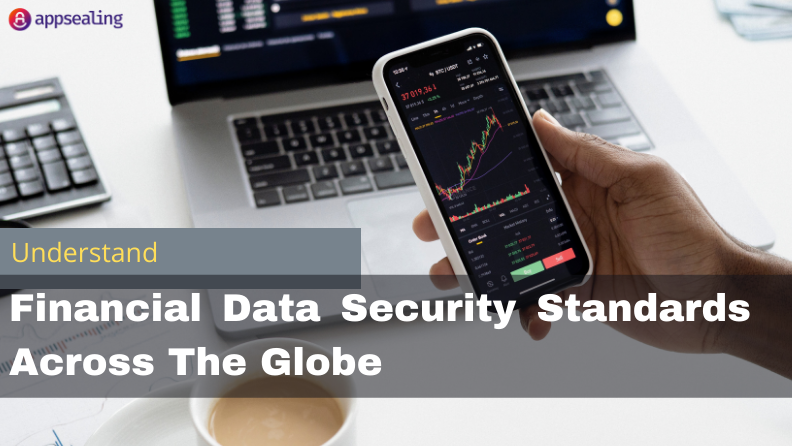2021 marked a period of tremendous innovation in the digital banking sector. These innovations were followed by great regulatory changes across the globe. Every player in the global financial system, from national banks to credit unions – must stay up-to-date on these regulatory changes. Why is regulatory compliance becoming an increasingly critical part of the financial services industry? There are many reasons.
Financial service providers work with extremely sensitive customer information. They store, process, and share the personal data of customers, their financial records, etc. All of these are of high interest to cyber-attackers. As these cybersecurity risks increase, so do the number of regulatory mandates that impact financial service providers.
Ready to protect your app?
Start 30-days FREE TRIAL. No credit card required. Deliver Secure Mobile Apps Faster in minutes with the leader in application security.

The consequences of non-compliance and subsequent data breaches are very serious for every player in the financial services industry. As regulatory pressures increase in this sector, non-compliant companies will face higher fines, reputational damage and the loss of customers.
Conversely, observing the requirements of these local, national, and international regulations helps companies manage cyber risks more efficiently. Adherence to compliance regulations at the cybersecurity level also means –
- Companies will invest in better security systems to protect sensitive customer information.
- The organization will gain a broader view of its critical systems and data security policies.
- Companies will better understand which cybersecurity strategies or techniques they should prioritize.
Let’s review the most important data security standards and regulations that impact financial services providers.
Financial Data Security Standards & Regulations
Local and international institutions have created many compliance regulations to ensure that sensitive customer data is protected appropriately. Here are the most important national/international regulations and protocols that apply to the financial services sector –
1. International Data Security Standards
There are various international data security standards that impact every company in the financial sector.
The Payment Card Industry Data-Security Standard
The Payment Card Industry Data-Security Standard (PCI-DSS) mainly addresses credit card issues. It aims to boost the protection of card users by ensuring secure data transmission, processing, and storage. The Payment Card Security Standards Council (PCI-SSC) is in charge of the administration of this standard on all card providers.
The PCI-DSS was mainly developed in the USA. But, it applies to card providers like VISA or Mastercard that operate in multiple countries. Hence, the PCI-DSS has global implications. Every payment service provider in the world must comply with this standard. The standard aims to reduce credit card fraud, a crime that cost the world approximately $28.58 billion in 2021. PCI-DSS has six goals –
- Securing cardholder data
- Building and sustaining a secure credit card payment network
- Maintaining vulnerability management programs
- Employing strong access control steps
- Constant monitoring/testing of networks
- Ensuring companies follow up-to-date information security policies
How can companies achieve PCI-DSS compliance? There are twelve security requirements they must meet. They include –
- Employing and preserving firewalls that secure cardholder data
- Creating and revising unique system passwords (not generic, vendor-provided passwords)
- Securing cardholder data via encryption; ensuring all cardholder data is encrypted via regular scans.
- Making sure cardholder data is never transmitted when the location is unknown, or the data is not encrypted.
- Deploying the latest anti-virus software tools.
- Deploying up-to-date information security systems
- Limiting the access of third-party organizations to cardholder data
- Giving every employer who has access to cardholder data unique IDs
- Restricting access to physical copies of cardholder data on a need-to-know basis.
- Using access logs to monitor when, who, and how individuals/organizations access cardholder data.
- Conducting regular scans to detect system vulnerabilities.
- Ensuring all employees, contractors, and other members of the organization follow these information security steps via strict company policies.
Creating and sustaining firewalls to prevent unauthorized access is a key requirement of the PCI-DSS. As per PCI-DSS requirement 11.4, all financial institutions must also create and maintain Intrusion Detection Systems to constantly detect/prevent network intrusions.
The SWIFT Customer Security Program
The SWIFT Customer Security Program applies to members of the Society for Worldwide Interbank Financial Telecommunications, or “SWIFT.” It’s an international messaging network that carries 5+ billion financial messages every year. Financial institutions use it to send/receive financial information accurately, quickly, and securely.
The SWIFT CSP compels financial institutions to improve their defensive strategies against cyber-attacks. All users of SWIFT services must adhere to the SWIFT CSP requirements. That means ensuring that their cybersecurity efforts are up-to-date and effective. Adhering to these requirements ultimately protects the integrity of the international SWIFT financial network.
2. European Data Security Standards
The Payment Services Directive 2
The Payment Services Directive 2 or PSD2 is one of the most critical pieces of legislation impacting all payment service providers operating in the European Economic Area (EEA). The aims of this set of directives include –
- Making payment regulations up-to-date as per current market requirements.
- All entities involved in accepting/processing electronic payments must adhere to stricter security requirements.
- Protection of consumers’ payment data.
- Banks and financial institutions must recognize the third-party providers (TPPs) that customers allow to access their financial data.
Banks and other major financial institutions are now obligated to hand over customer data to TPPs if the customer consents. With this directive, the PSD2 intends to bridge the gaps between PSPs, banks, and fintech companies. However, it also gives banks the responsibility to deploy secure APIs that enable secure data sharing with other financial institutions.
Payment Service Providers (PSPs), Third-Party Providers (TPPS), and Payment Initiation Service Providers (PISPS) must implement multi-factor authentication for all transactions. This means implementing Strong Customer Authentication (SCA) – a key condition of the PSD2 directives.
Under this regulation, PSPs must ask customers for at least two authentication features or factors based on these elements –
- Knowledge: Something/s that only the customer knows (e.g., passwords)
- Possession: Something, only the customer, possesses (e.g., a registered mobile phone)
- Inherence: Something, the customer, is (e.g., biometric data).
The selected factors need to be mutually independent of one another. Hence, in case there’s a data breach, one compromised factor (e.g., a stolen password) cannot compromise the other security factors. In effect since 14th September 2019, the PSD2 aims to create an integrated and secure payment market in the EU.
The PSD2 Regulatory Technical Standards
The PSD2 Regulatory Technical Standards or PSD2-RTS lists the specific procedures to protect customer data for payment agents. It also details the specific responsibilities/obligations of PSPs, TPPs, and other financial institutions. The PSD2-RTS mandates the use of eIDAS (electronic Identification, Authentication and trust Services) for all PSPs.
The General Data Protection Regulation
The General Data-Protection Regulation or the GDPR is another European regulation affecting financial services companies at the EU level. Passed in Q3 of 2018, the GDPR is a comprehensive set of regulations that govern data management within the EU. It aims to give citizens more control over their private data by standardizing how data is managed between EU nations.
Although GDPR is strictly EU law, it impacts any organization that has a presence in Europe. For international organizations, it’s better to apply GDPR-compliant policies than face hassles every time they do business in the EU. The GDPR is very clear about the data collection policies that companies follow. Companies collecting sensitive customer data must follow these seven principles –
- Accountability
- Accuracy
- Confidentiality and integrity
- Data minimization
- Purpose limitation
- Storage limitation
- Transparency and lawfulness
GDPR is the most comprehensive piece of EU legislation passed in recent times. It aims to standardize financial security standards in an ever-digitizing economy and protect private customer data. Fines for non-compliance reach up to €20 million.
The Network and Information Systems Security Directive
The Network and Information Systems Security (NIS Directives) directive provides legal measures to improve cybersecurity levels in the EU. Here are some basic functions of the NIS directive –
- Ensuring all Member States are prepared for cybersecurity incidents.
- Making sure they’re equipped with CSIRTs (Cybersecurity Incident Response Teams).
- Launching cooperation groups to promote cooperation between the Member States.
- Increasing cyber-safety in all sectors that are critical to the economy.
3. Data Security Standards in the United States of America
There are multiple data security regulations that organizations operating in the US need to follow. Some are implemented on a national level (e.g., FINRA), while others are state-based (NYDFS). Here are some US regulations that cover financial transactions, customer data storage, and financial fraud 0
The Gramm-Leach-Bliley Act (GLBA)
This data security and privacy law applies to all banks, securities firms, and other financial service providers in the US. As per the GLBA’s data security rule (16 CFR Part 314), all financial organizations must create, implement, and preserve strict data security programs that contain data safety measures (physical, administrative, and technical) appropriate for the organization’s size and complexity.
All financial service providers must notify consumers about how their data is shared and what data protection measures they follow. GLBA-compliant organizations must also give customers the option to not share their data with third parties. Not implementing or violating the GLBA could lead to penalties of up to $1 million. The “Financial Services Modernization Act” is another name of this law.
The Sarbanes Oxley Act (SOX)
The Sarbanes Oxley Act describes the best practices organizations should implement to avoid processing fraudulent financial transactions. It’s applicable to all US public companies. It stipulates how financial records should be protected, which financial records should/shouldn’t be stored and for how long.
The Making Online-Banking Initiation Legal and Easy Act (MOBILE Act)
The Making Online-Banking Initiation Legal and Easy Act enables banks to accept customers through less complicated online verification processes. The MOBILE Act supersedes the previous restrictions levied by the Dodd-Frank Act. It allows the use of e-signatures for online verification of bank customers.
State Cybersecurity Laws
All 50 states in the US have state-specific cybersecurity laws that local companies must follow to avoid cybersecurity breaches. New York and California are the two states where most of these state-specific cybersecurity regulations apply. That’s because most tech or fintech companies are located in these two states. Some important state-specific cybersecurity regulations include –
- The Californian Consumer Privacy Act (CCPA)
- The California Privacy Rights and Enforcement Act (CPRA)
- New York’s SHIELD Act Of 2019
- The New York State DFS (Department of Financial Services) Cybersecurity Regulations
Important Data Security Standards Across the Globe
Different countries have different security frameworks for financial organizations. These regulations have impacts on other institutions across the globe. Here are some notable data security regulations in major countries –
- The CIIP Framework in France
- The Digital Payment Security Controls in India
- The Regulations for the Protection of Critical Infrastructures in Spain
- The SAMA Cyber Security Framework in Saudi Arabia
Best Practices for Banking and Financial Cybersecurity Compliance
Each data security law and cybersecurity standard impose different and complicated requirements. Addressing these requirements may seem hard. But, enhancing the security of critical data management systems should be every company’s priority. That’s why organizations are advised to follow these simple but effective practices to achieve total compliance –
Differentiate Between Personal Data and Sensitive Personal Data
Moving forward, companies will need stronger reasons to process “Sensitive Personal Data” compared to “regular” personal data. Hence, making clear distinctions between the two is critical for both companies and regulators. CFOs must clarify these distinctions by establishing an open dialogue with relevant regulatory agencies.
Conduct Periodic Risk Assessments
Conducting routine risk assessments gives companies a better understanding of the weak spots and vulnerabilities in their IT infrastructures. For example, approximately 90% of all cyberattacks in the financial industry start with phishing attacks. Hence, organizations in the financial sector should be extra privy to phishing attacks.
Launch Data Privacy Frameworks
To achieve compliance with major data privacy regulations, companies must take a structured approach. That means –
- Defining and implementing robust governance models to lay out data privacy programs in their organizations.
- Reviewing, designing and implementing target operating models
- Reviewing the existing capabilities of the information systems used in the company and rolling out more up-to-date information security systems.
Monitor User Activity
Continuous monitoring of user activity is a critical requirement of many cybersecurity directives (e.g., PCI-DSS, SOX, etc.). It helps companies detect/prevent suspicious events. Companies are also more likely to spot early signs of cyberattacks or stop them while they’re happening with constant activity monitoring. Privileged users in any network should be monitored more closely. User-Entity Behavior Analytics (UEBA) tools can be used to apply different levels of monitoring to different groups of users.
Encryption
Data encryption is recommended by the GDPR, the PCI-DSS, and is mandatory as per ISO standards. Stolen data can only be used when it’s not encrypted. Companies must find solutions to encrypt customer data at all stages. Customer data should be encrypted when it’s at rest and during data transmissions.
Third-Party Risk Management
Third-party risk management is the process of minimizing the risk of data breaches by closely monitoring third-party contractors, subcontractors, etc. Here are some easy steps financial institutions and banks can take to manage third-party risks –
- Limit the access contractors or subcontractors have to critical customer data.
- Grant access to third-party organizations with different levels of importance.
- Closely monitor the activities of all third parties that have access to the network.
- Ensuring third parties comply with all relevant cybersecurity standards and data security regulations.
Establishing a zero-trust model when it comes to giving access to critical assets can help financial institutions achieve these objectives. Enforcing multi-factor authentication (MFA) systems throughout the network is the best way to start this process.
Create Incident Response Plans
Every institution in the financial sector should have well-defined cybersecurity policies. A key aspect of these policies should be incident response plans. Companies must have a clear plan of action in case they experience data breaches. These plans should include
- Clear action scenarios for different types of cybersecurity incidents.
- Clarify what is or isn’t a cybersecurity incident.
- What first steps the company should take in case of a cyberattack.
- How to restore lost data.
- How to minimize the number of systems the cyberattack affects.
- Which authorities to notify for reporting cybersecurity incidents.
- Minimum response times for cybersecurity incidents.
The Cost Implications of Non-compliance
The costs associated with cyberattacks and data breaches due to non-compliance have been rising significantly over the last few years. For example, Amazon was asked to pay a fine of $887 million (€746 million) because of non-compliance with the GDPR. The average costs of detecting data breaches and launching appropriate response plans have also increased significantly.
How can companies avoid these non-compliance fines? By implementing a strong data compliance framework that facilitates observance of relevant data privacy regulations. Serious focus is necessary to implement and upgrade data compliance frameworks across all organizational operations and information systems. However, by doing so, companies operating in the financial sector can avoid financial penalties and reputational risks to their businesses.
Emerging Trends in Financial Data Protection
Companies operating in the financial sector will have to overcome many challenges to implement the best data protection practices. Firstly, they’ll have to win the trust of their customers by setting up well-defined data security architectures. These efforts shouldn’t come at the cost of limiting networking or data-sharing opportunities. Or else, financial institutions won’t be able to capitalize on emerging growth opportunities.
That’s why implementing data protection by designing new data security architectures is so challenging. Who should have access to sensitive customer data, and to what extent? What level of data access is necessary to carry out regular tasks in a modern-day financial organization? These challenges are pushing companies towards a similar solution – encryption.
With encryption, financial institutions can gain better control over their data in a much more hands-on manner. Companies must access top-notch encryption architectures, especially the ones that support AES 256 encryption. It’s the most robust encryption standard in the world.
The financial industry is frequently targeted by cybercriminals due to the perceived value of the data their systems contain. Once cyber-attackers learn that all data in your company’s network is encrypted, they’ll stop targeting you.
Final Thoughts
Internationally, there’s a paradigm shift in how banking and financial services are being provided. The COVID19 pandemic has also compelled customers and organizations to embrace a “less-cash economy” and digital solutions.
Naturally, many financial institutions are switching to cloud infrastructures and improving the UX (user experience) of their digital platforms. Simultaneously, evolving cybersecurity threats are forcing far-reaching regulatory changes. Amidst all these changes, it’s not easy for financial institutions to give enough attention to growing cybersecurity concerns. That’s why third-party solutions like AppSealing are critical to the international fintech industry.
AppSealing is the world’s leading mobile app security solution provider. With AppSealing’s top-notch encryption architectures, companies can secure all sensitive data in their networks, deter cyberattacks, and achieve full compliance with security standards. AppSealing’s solution supports AES 256 encryption and provides industry security standards like PCI-DSS, GDPR, etc. AppSealing’s end-to-end data encryption solutions help companies achieve compliance instantly without any SDK integrations or coding. Get in touch with us today to create safe and compliant walls of security around your data.
Ready to protect your app?
Start 30-days FREE TRIAL. No credit card required. Deliver Secure Mobile Apps Faster in minutes with the leader in application security.







